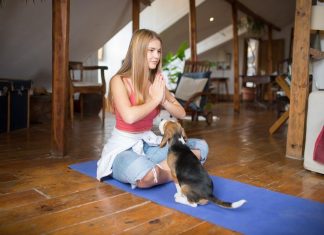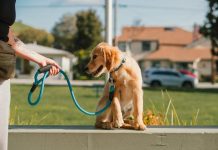Welcoming a new puppy into your home is an exciting and joyful experience, filled with moments of playful energy and boundless affection. However, as any pet owner knows, a young pup’s exuberance can sometimes turn into overwhelming chaos, especially in unfamiliar or stimulating environments. Teaching your puppy to stay calm in any situation is not just about ensuring peace in your household; it’s about fostering a sense of security and confidence in your furry friend. In this guide, we will explore practical techniques and gentle training methods that will help your puppy remain composed, whether you’re navigating a bustling park, a busy street, or simply a new visitor at the door. With patience, consistency, and love, you can equip your puppy with the skills to face the world calmly and joyfully. Let’s embark on this rewarding journey together!
Creating a Safe and Comfortable Environment for Your Puppy
Ensuring your puppy feels secure and at ease starts with the right environment. Begin by designating a cozy corner in your home where your puppy can retreat when feeling overwhelmed. This space should be equipped with a soft bed, a few favorite toys, and access to water. Consider using a crate or a playpen to provide a sense of security, especially during the initial days. Puppies thrive on routine, so establish consistent feeding and potty schedules to build trust and predictability.
- Reduce loud noises: Keep the area quiet and free from sudden loud sounds that might startle your puppy.
- Introduce calming scents: Use calming pheromone diffusers or sprays designed for puppies to help them relax.
- Maintain a comfortable temperature: Ensure the area is neither too hot nor too cold, adjusting as needed to keep your puppy comfortable.
Moreover, gentle exposure to new environments and stimuli is crucial. Gradually introduce your puppy to different rooms, people, and noises, always ensuring these experiences are positive. Reward calm behavior with treats and affection to reinforce a sense of calmness. Remember, patience and consistency are key in nurturing a confident and relaxed puppy.
Understanding Your Puppys Triggers and Calming Signals
Every puppy has unique triggers that can cause excitement, fear, or stress. Recognizing these triggers is the first step toward helping your puppy maintain calmness in any situation. Observe your puppy closely to identify what makes them uneasy. It could be loud noises, unfamiliar environments, or even certain types of people or animals. Once you’ve pinpointed these triggers, you can work on desensitizing your puppy gradually. Introduce them to the trigger in a controlled setting, ensuring it’s at a level that doesn’t overwhelm them. Gradually increase their exposure, rewarding calm behavior with treats and praise. This process helps them build a positive association with what once caused them anxiety.
In addition to understanding triggers, it’s essential to become familiar with your puppy’s calming signals. These are subtle body language cues that indicate your puppy is trying to relax or avoid confrontation. Look out for signs such as:
- Licking their lips
- Yawning
- Turning their head away
- Slow blinking
- Lowering their body
By acknowledging these signals, you can intervene early and guide your puppy back to a state of calmness. Reinforce these moments with gentle words and soothing touches, helping your puppy feel secure and understood. Over time, this will strengthen your bond and enhance their ability to remain composed, even when faced with challenging situations.

Implementing Consistent Training Techniques with Patience
Training your puppy to remain calm involves consistency and patience, essential elements for developing a strong foundation of trust and understanding. Begin by setting a routine that aligns with your puppy’s natural energy levels. Introduce short, focused training sessions at the same time each day, ensuring that your pup knows what to expect. Consistency helps reinforce the desired behavior, while your patience will nurture your puppy’s ability to learn at its own pace.
- Start with simple commands: Before tackling complex scenarios, ensure your puppy can follow basic commands like “sit” and “stay”.
- Use positive reinforcement: Reward calm behavior with treats, praise, or playtime to create a positive association.
- Gradually increase distractions: Once your puppy masters commands in a quiet environment, slowly introduce new distractions, like other pets or noises, to test their calmness.
- Practice daily: Consistent practice helps your puppy understand that staying calm is always the goal, regardless of the situation.
Remember, every puppy learns at their own pace. If your furry friend struggles, step back and assess the situation. Sometimes, a little more time and patience can make all the difference in helping your puppy remain composed and content.

Using Positive Reinforcement to Encourage Calm Behavior
Positive reinforcement is a powerful tool for nurturing a calm demeanor in your puppy. By rewarding desired behaviors, you can effectively guide your puppy toward becoming more composed and confident. Start by identifying specific behaviors you want to encourage, such as lying quietly, sitting calmly, or waiting patiently. Use rewards like treats, praise, or playtime to reinforce these behaviors. Timing is crucial—reward your puppy immediately after they display the desired behavior to strengthen the association.
- Consistency: Make sure everyone in the household is on the same page about which behaviors are rewarded to avoid confusing your puppy.
- Patience: Remember, learning takes time. Be patient and consistent in your approach to see lasting results.
- Incremental Steps: Start with simple tasks and gradually increase the difficulty as your puppy masters each step.
Over time, your puppy will start associating calmness with positive outcomes, making it a natural part of their behavior repertoire. This approach not only encourages tranquility but also strengthens the bond between you and your furry friend, making training a joyful and rewarding experience for both of you.
















